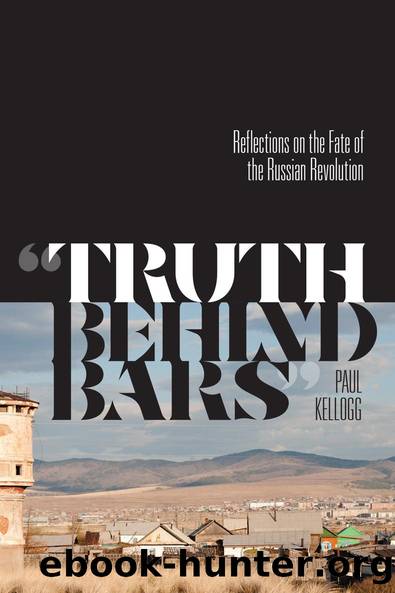Truth Behind Bars by Paul Kellogg

Author:Paul Kellogg [Kellogg, Paul]
Language: eng
Format: epub
Tags: History, Russia & the Former Soviet Union, Political Science, Political Ideologies, Communism; Post-Communism & Socialism
ISBN: 9781771992459
Google: azRTEAAAQBAJ
Publisher: Athabasca University Press
Published: 2021-11-05T02:51:03+00:00
His invocation of the continuing âsocialist consciousness of the massesâ was analyzed earlier, in chapter 5. If, as was argued in that chapter, there is little evidence of the continuing âsocialist consciousness of the massesâ in the 1930s, then indeed the only remaining criterion for claiming the continuation of socialism in the USSR would be nationalization of the means of production. Importantly, however, Trotsky concludes his point with the following caveat: âBut let us bear in mind that the unwinding process has not yet been completed, and the future of Europe and the world during the next few decades has not yet been decided.â29 Trotsky then proceedsâin the paragraph that Woods so painstakingly revised from the Malamuth translation and throughout the book in other nonrevised sectionsâto suggest and develop a completely different criterion by which to assess the class nature of the Soviet Unionâthe control of the surplus product.
Trotsky asserts that âthe substance of the Thermidor was, is and could not fail to be social in character. It stood for the crystallization of a new privileged stratum, the creation of a new substratum for the economically dominant class. There were two pretenders to this role: the petty bourgeoisie and the bureaucracy itself.â30 The petty (or petite) bourgeoisie (by this, he means primarily the so-called rich peasants) is clearly a class designation, but here he is putting the bureaucracy in the same category, which suggests that, in his thinking, it too was becoming a class.
In the latter half of Stalin, in notes that are slightly different versions of early material in the book, Trotsky writes: âPossession of the surplus produce opened the bureaucracyâs road to power.â31 Developing a class analysis on the basis of control of the surplus product is, of course, the essence of Marxâs methodâand of historical materialism. However, Trotsky does not draw the conclusion that this control of the surplus product by a state elite results in a new class. Rather, he suggests that âthe introduction of a liberal economic regime was out of the questionâ¦. A liberal regime based on private property means the concentration of wealth in the hands of the bourgeoisie and its upper layers. But the privileges of the bureaucracy did not flow from the automatic development of the existing economic relations.â32 True enough. But students of capitalism are all too aware that while aspects of capitalismâs present might be âliberal,â there was nothing liberal about its origins in state-directed mercantilism and the completely illiberal trans-Atlantic slave trade.
Souvarine makes many of the same points that Trotsky does, but does not hesitate to conclude that the Soviet Union is no longer in any way progressive or that it constitutes some kind of a workersâ state. âSo-called Soviet society rests on its own method of exploitation,â he writes, âof man by man, of the producer by the bureaucracy, of the technician by the political power.â
For the individual appropriation of surplus value is substituted a collective appropriation by the State, a deduction made for the parasitic consumption of functionaries.
Download
This site does not store any files on its server. We only index and link to content provided by other sites. Please contact the content providers to delete copyright contents if any and email us, we'll remove relevant links or contents immediately.
| Anarchism | Communism & Socialism |
| Conservatism & Liberalism | Democracy |
| Fascism | Libertarianism |
| Nationalism | Radicalism |
| Utopian |
The Secret History by Donna Tartt(18694)
The Social Justice Warrior Handbook by Lisa De Pasquale(12069)
Thirteen Reasons Why by Jay Asher(8716)
This Is How You Lose Her by Junot Diaz(6689)
Weapons of Math Destruction by Cathy O'Neil(6068)
Zero to One by Peter Thiel(5618)
Beartown by Fredrik Backman(5533)
The Myth of the Strong Leader by Archie Brown(5358)
The Fire Next Time by James Baldwin(5185)
How Democracies Die by Steven Levitsky & Daniel Ziblatt(5083)
Promise Me, Dad by Joe Biden(5029)
Stone's Rules by Roger Stone(4981)
100 Deadly Skills by Clint Emerson(4785)
A Higher Loyalty: Truth, Lies, and Leadership by James Comey(4768)
Rise and Kill First by Ronen Bergman(4643)
Secrecy World by Jake Bernstein(4584)
The David Icke Guide to the Global Conspiracy (and how to end it) by David Icke(4539)
The Farm by Tom Rob Smith(4397)
The Doomsday Machine by Daniel Ellsberg(4366)
